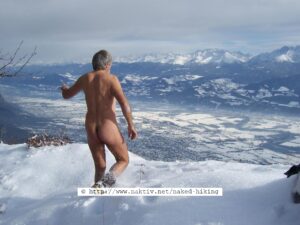Then clothing. This will be necessary anyway at one time or another, especially at the outset, when the muscles are still stiff and cold. Once you get going, the muscles will soon warm up, then clothes become redundant and can be removed layer by layer. However, unlike shorts in summer which are quickly removed, in winter things get complicated.
I t’s an acrobatic feat to avoid soaking your clothes while undressing in the snow, not to mention dressing again in a hurry. So you need to choose your outfit carefully. In practice, what I find works best are over-trousers worn directly on the skin, which unzip completely at the sides so that you can keep your boots on, worn with polar-grade jackets and vests. In deep snow, gaiters will prevent snow getting into your boots. Heat loss is mainly from the extremities, so gloves and a hat are de rigueur.
t’s an acrobatic feat to avoid soaking your clothes while undressing in the snow, not to mention dressing again in a hurry. So you need to choose your outfit carefully. In practice, what I find works best are over-trousers worn directly on the skin, which unzip completely at the sides so that you can keep your boots on, worn with polar-grade jackets and vests. In deep snow, gaiters will prevent snow getting into your boots. Heat loss is mainly from the extremities, so gloves and a hat are de rigueur.
Extra dry warm clothes will also be needed in case of sudden changes in temperature. Make sure you have really effective sunglasses, otherwise you will suffer sore eyes, or even snow-blindness. The rest of the gear is that of any winter mountain hike: water, food, warm gore-tex jacket, rescue equipment, including a snow shovel, phone, gps, maps, and camera.
Extract from the Naked Hiking book, chapter by Jacques-Marie Francillon